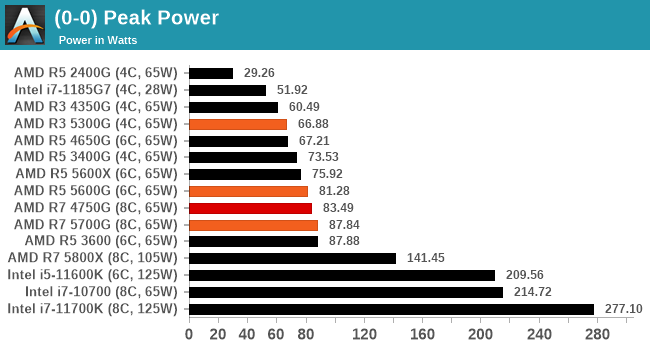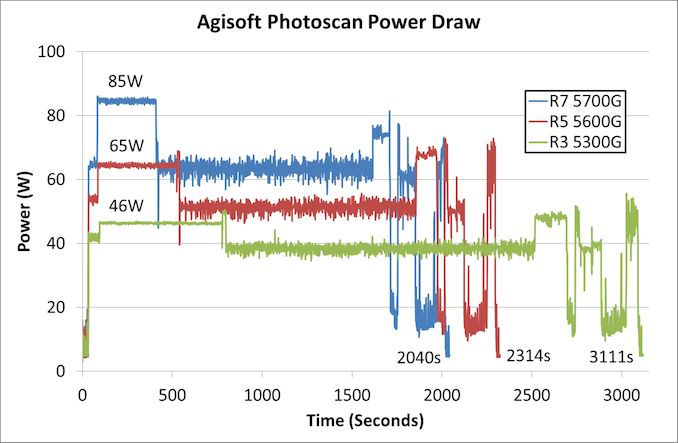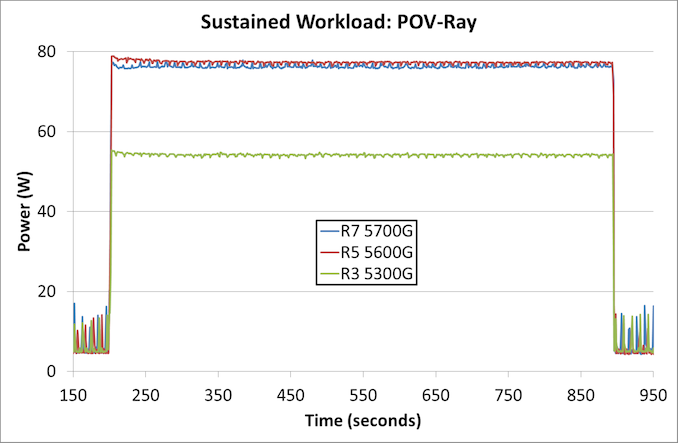The AMD Ryzen 7 5700G, Ryzen 5 5600G, and Ryzen 3 5300G Review
by Dr. Ian Cutress on August 4, 2021 1:45 PM ESTPower Consumption
The nature of reporting processor power consumption has become, in part, a dystopian nightmare. Historically the peak power consumption of a processor, as purchased, is given by its Thermal Design Power (TDP, or PL1). For many markets, such as embedded processors, that value of TDP still signifies the peak power consumption. For the processors we test at AnandTech, either desktop, notebook, or enterprise, this is not always the case.
Modern high-performance processors implement a feature called Turbo. This allows, usually for a limited time, a processor to go beyond its rated frequency. Exactly how far the processor goes depends on a few factors, such as the Turbo Power Limit (PL2), whether the peak frequency is hardcoded, the thermals, and the power delivery. Turbo can sometimes be very aggressive, allowing power values 2.5x above the rated TDP.
AMD and Intel have different definitions for TDP, but are broadly speaking applied the same. The difference comes to turbo modes, turbo limits, turbo budgets, and how the processors manage that power balance. These topics are 10000-12000 word articles in their own right, and we’ve got a few articles worth reading on the topic.
- Why Intel Processors Draw More Power Than Expected: TDP and Turbo Explained
- Talking TDP, Turbo and Overclocking: An Interview with Intel Fellow Guy Therien
- Reaching for Turbo: Aligning Perception with AMD’s Frequency Metrics
- Intel’s TDP Shenanigans Hurts Everyone
In simple terms, processor manufacturers only ever guarantee two values that are tied together - when all cores are running at base frequency, the processor should be running at or below the TDP rating. All turbo modes and power modes above that are not covered by warranty. Intel kind of screwed this up with the Tiger Lake launch in September 2020, by refusing to define a TDP rating for its new processors, instead of going for a range. Obfuscation like this is a frustrating endeavor for press and end-users alike.
However, for our tests in this review, we measure the power consumption of the processor in a variety of different scenarios. These include workflows, real-world image-model construction, and others as appropriate. These tests are done as comparative models. We also note the peak power recorded in any of our tests.
First up is our image-model construction workload, using our Agisoft Photoscan benchmark. This test has a number of different areas that involve single thread, multi-thread, or memory limited algorithms.
For the Ryzen 7 5700G, the most power-hungry part of the test is right at the beginning, where we’re seeing peaks of 85 W. For the 5600G, that first section goes to 65 W, but the peaks actually occur here near the end of the test. The 5300G also has peaks later in the test, but that first section is the lowest, running only at 46 W.
The second test is a sustained rendering workload.
In this instance, the Ryzen 3 5300G is nearer 55 W with a sustained workload over 10 minutes, while the Ryzen 5 and Ryzen 7 sit just below 80 W.
For peak power, we report the highest value observed from any of our benchmark tests.

While all three processors have a TDP rating of 65 W, by default on AMD systems the Package Power Tracking, which is the limiting factor here, is 88 W. The Ryzen 7 is practically at that value, while the Ryzen 5 just goes a smidge over 80 W. The Ryzen 3 on the other hand only matches its TDP in the worst-case scenario.












135 Comments
View All Comments
Dribble - Friday, August 6, 2021 - link
Might be because it isn't as power limited and hence won't throttle in the same way the AMD chip.Danvelopment - Thursday, August 5, 2021 - link
Is the 5600G 6 core or 8 core? The first page of the article says it's both on the two tables.eastcoast_pete - Thursday, August 5, 2021 - link
Now, imagine if those 5700 APUs would have kept the core numbers of the 3400, but clocked at current speeds. I hope that Intel will bring its 10 nm Desktop CPUs with the full Xe compliment of mobile Tiger Lake, as that might force AMD to up its game; well, the next APU generation will be RDNA2, so as long as AMD doesn't gimp it by keeping the GPU tiny, it should have significant uplift over CézanneCooe - Friday, August 6, 2021 - link
Far Cry 5 running at ≈25fps on average at "1080p Ultra" is actually CRAZY freaking impressive. Why? Because that means it should hit a solid >=30fps running at "1080p High", which basically means that this single chip APU solution is outperforming BOTH of the last generation console base models (aka PS4 & Xbox One/S) in this title!!! That's freaking NUTS!!!nandnandnand - Tuesday, August 10, 2021 - link
I wouldn't be surprised to see 1080p60 in the same scenarios with Rembrandt next year. But DDR5 will be expensive.nanonan - Friday, August 6, 2021 - link
Every other source I've read states the pcie configuration as 24 lanes divided into 16, 4 and 4 just like the 4000G series. Do you have a source for this 8+4+8 configuration?linuxgeex - Friday, August 6, 2021 - link
Anand wasn't perfect with proofing either but he was thorough on deep dives, exposing bottlenecks and explaining how and why it was relevant. These days Ian and co assume that if we're Anandtech readers we just trust their methodology and do some lip service by adding cut&paste boilerplate around specs and throw in an image sometimes from a past review, sometimes not directly relevant, and I get that they only have so much time to invest. It bores me, and it doesn't give the new people the same level of engagement that will built their future audience. Oh welles.Samus - Friday, August 6, 2021 - link
I blacked out after getting to the part where an entry-level AMD APU starts at $259.While I get yes there are the Athlon's, they are mostly outclassed by a 9th gen $90 Intel Core i3 so it isn't even worth consideration.
GeoffreyA - Saturday, August 7, 2021 - link
Yes, pricing is disappointing.mode_13h - Sunday, August 8, 2021 - link
They're starting strong, because it's a lot easier to lower prices than raise them, and that pricing reflects the supply/demand situation, especially when the 3000-gen are still widely available.Over time, I'm sure you can expect to see the gap close, particularly since the process node is the same and die sizes are similar.